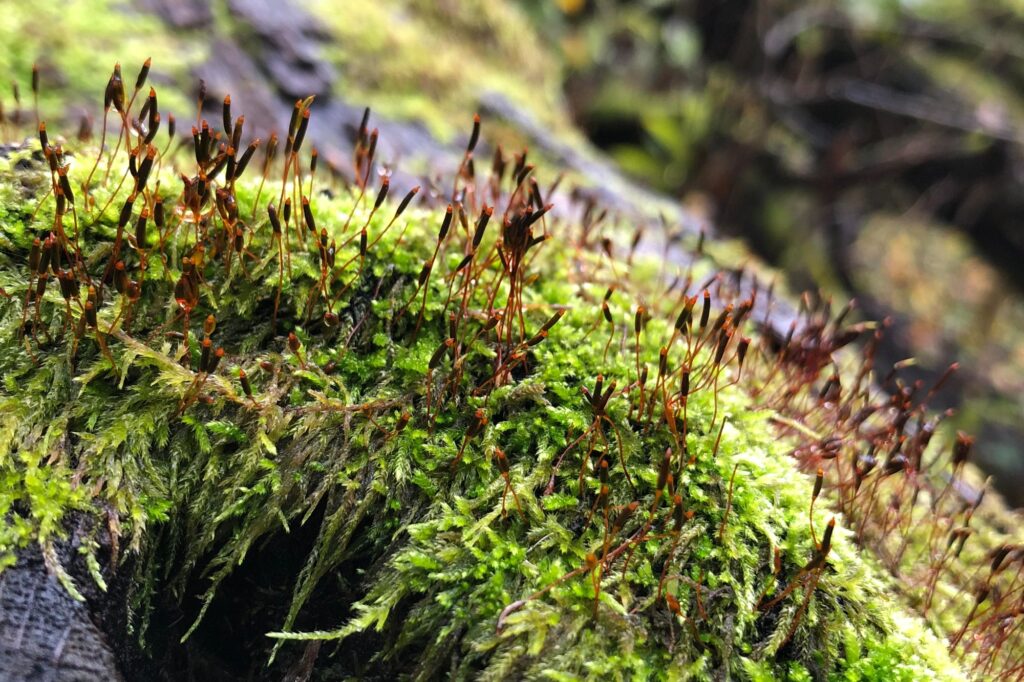I’ve always been one to look for wildlife when outdoors. Rustling in the branches overhead, a tail disappearing around a corner, the rise and fall of wings against a cobalt blue sky.
This human instinct to watch for movement, and my background in zoology, tends to perpetuate a certain amount of plant blindness. Plants are often filtered through my brain as the rich green backdrop for critter-spotting and it takes a bit of concentrated effort to spot the plants I’ve become familiar with. However, there’s one delightfully green growing life form that has always caught my eye, moss. Tucked into the bark of an oak or slicked against a rock alongside the river, moss is inviting. It’s spongy, it’s dainty, it’s deceptively complex.
Despite its small stature, mosses are resilient and can be found on every continent. If there are plants present and sunlight to spare, you can bet you’ll find moss there. The key to this success is that mosses are masters at retaining moisture, and they have to be! Because they lack roots and vascular tissue, there are no internal highways to transport water and nutrients. So, moss stays low and small, holds water like a sponge, fosters humidity between its leaves, and uses hair-like structures called rhizoids to anchor itself to its habitat. If it gets a little too dry, or too freezing, some mosses can go dormant. It will curl in on itself and wait for the sun or rain to return before unfurling and kicking off photosynthesis.
When it’s time to make more moss, they grow a multitude of small stalks and release spores– little packages of singular cells that will grow into another bed of moss. By simply going about their business, these small plants help to keep water in their environment, moderate soil temperatures, and prevent erosion.
Creatures benefit from moss too. Some insects, like the aptly named moss bugs, are moss grazers and dine on the very leaves they live within. Other insects will use beds of moss as a watering hole, a dining hall, or a safe place to lay eggs. Shrews, mice, and even turtles will use some kinds of moss as shelter. But the most intriguing inhabitant of moss is the tardigrade! These microscopic invertebrate “water bears” envelop themselves in the moisture of mosses to survive and then feed on algae and small insects found within the moss.
With over 12,000 species of moss, it can be hard to know where to begin if you’re looking to understand moss. As with most things in life, the best way is simply to start! Get up close and personal, find a magnifying glass, or take some photos to see moss in more detail: are the leaves flat and broad or whorled, curled, and skinny? Most importantly, be curious about what you’re observing and compare what you see.
It’s easy to lose sight of what’s underfoot. The hubbub of the world presses in around us and demands attention. But there’s a whole world happening within moss. The magic of moss is in the way it encourages us to find slowness, to get closer to nature, and to hydrate. Moss shows us that the world is filled with, and is made possible by, much smaller beings than us. To enjoy that beauty and wonder, all we have to do is take a moment to observe.
If you’d like to learn more about moss, and see what inspired this article, I encourage you to explore one of Red-tail Land Conservancy’s public preserves, like Fall Creek Woods. Or check out the book “Gathering Moss: A Natural and Cultural History of Mosses” by Robin Wall Kimmerer.
Photo: Moss by Emily Grant
Emily Grant is Red-tail’s Stewardship Coordinator, Land Protection. She is eager to preserve the native habitats that inspired her love of wildlife, so they may be a source of beauty and safety for those who need them.




